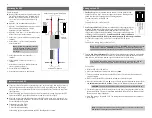
4
FMA limited warranty for electronic speed controls
FMA, Inc. warrants this product to be free of manufacturing defects for the term of 90 days from the date of pur-
chase. Should any defects covered by this warranty occur, the product shall be repaired or replaced with a unit of
equal performance by FMA or an authorized FMA service station.
Limits and exclusions
This warranty may be enforced only by the original purchaser, who uses this product in its original condition as
purchased, in strict accordance with the product’s instructions. Units returned for warranty service to an FMA
service center will be accepted for service when shipped postpaid, with a copy of the original sales receipt or
warranty registration form, to the service station designated by FMA.
This warranty does not apply to:
Consequential or incidental losses resulting from the use of this product.
Damage resulting from accident, misuse, abuse, neglect, electrical surges, reversed polarity on connectors,
lightning or other acts of God.
Damage from failure to follow instructions supplied with the product.
Damage occurring during shipment of the product either to the customer or from the customer for service
(claims must be presented to the carrier).
Damage resulting from repair, adjustment, or any alteration of the product by anyone other than an authorized
FMA technician.
Installation or removal charges, or damage caused by improper installation or removal.
Call (301) 668-7614 for more information about service and warranty repairs.
Super 30 ESC specifications
Model ASC30
Functions
Proportional throttle, throttle end point adjustment (EPA), brake,
battery eliminator circuit (BEC), low voltage cutoff (LVC), restart
Input
2 to 4 Lithium Polymer cells in series, or 5 to 12 NiCd/NiMH cells
in series (LVC enabled), 3 to 12 NiCd/NiMH cells (LVC disabled)
Input operating voltage
2.1 to 18 VDC
Motor support
1 DC motor, up to 30A current draw (does not support brushless
motors)
Frequency 1.5
kHz
Continuous output current 30 A
Peak output current
400 A (FET rating)
Internal resistance
2.75 milliohm
BEC output
5.0
±
0.5 VDC at 1A maximum
Dimensions
1.35" x 0.75" x 0.40" (34.3mm x 19mm x 10.2mm)
Super 30 ESC cell detect and low voltage cutoff specifications
For initial voltage
Pack type/size* is assumed to be
And cutoff voltage (when enabled) is
5.30 to 7.15 V
NiCd/NiMH, 5 cells
5.2 ±0.1 V
7.16 to 8.55 V
NiCd/NiMH, 6 cells; or LiPo, 2 cells
5.3 ±0.1 V
8.56 to 9.95 V
NiCd/NiMH, 7 cells
5.4 ±0.1 V
9.96 to 11.20 V
NiCd/NiMH, 8 cells
6.1 ±0.1 V
11.21 to 12.45 V
NiCd/NiMH, 9 cells; or LiPo, 3 cells
8.4 ±0.1 V
16.06 up
NiCd/NiMH, 12 cells; or LiPo, 4 cells
11.0 ±0.1 V
12.46 to 14.50 V
NiCd/NiMH, 10 cells
9.3 ±0.1 V
14.51 to 16.05 V
NiCd/NiMH, 11 cells
10.3 ±0.1 V
*number of cells connected in series
FMA, Inc. 5716A Industry Lane Frederick, MD 21704
Sales: (800) 343-2934 Technical: (301) 668-7614 www.fmadirect.com
Super 30 Auto Cell Detect
Electronic Speed Control
Model ASC30 for electric-powered aircraft using
Lithium Polymer, NiCd or NiMH battery packs
Features
Works with NiCd, NiMH and Lithium Polymer (LiPo) packs.
User switchable brake.
User switchable Low Voltage Cutoff. When enabled, cutoff voltage is automatically set based
on initial battery pack voltage.
Throttle End Point Adjustment (EPA).
Battery Eliminator Circuit (BEC) powers receiver from motor battery.
Heavy-duty diode reduces electrical noise.
Kokam/USA Lithium Polymer cells are the next-generation replacement for NiCd, NiMH and
Lithium Ion cells. This unique power technology offers high energy density, low weight, long
life, safe operation and environmentally-friendly chemistry. Order Kokam/USA cells and packs
through the Kokam/USA Web site, www.kokamusa.com (or www.fmadirect.com). LiPo technical
and application information is available in the Support section of the Web site.
Precautions
Follow all instructions in this manual to assure safe operation.
Observe frequency control. If someone else is operating a radio controlled model on the same
channel as your transmitter,
do not turn on your transmitter—even for a short time.
Your
transmitter has a channel number marked somewhere on its case. When a model receives
signals from two transmitters on the same channel at the same time, it cannot be controlled and
will crash—possibly causing personal injury or property damage.
For safety, most RC flying
fields have formal frequency control rules. Follow them carefully.
Do not operate your radio control transmitter within 3 miles of a flying field. Even at a
distance, your transmitter can cause interference.
Make sure your LiPo packs are above 3.7V/cell when you first connect them to the ESC and
apply power. The ESC sets its Low Voltage Cutoff by measuring initial pack voltage. If the
LiPo pack voltage is too low, the Low Voltage Cutoff may be set too low, and cells could be
over-discharged. Charge state is less critical for NiCd/NiMH packs, but it’s always a good idea
to start with a freshly charged pack.
The Super 30 ESC works with packs of 5 to 12 NiCd/NiMH or 2 to 4 LiPo cells in series. If
the Low Voltage Cutoff is disabled, the ESC supports packs with
3 to 4 NiCd/NiMH cells in
series (however, your receiver/servos may stop operating at the lower voltage near the end of a
run).
Never disable the Low Voltage Cutoff when using the ESC with LiPo packs.
Note:
When using LiPo batteries in fuel-powered models, use an FMA voltage
regulator/LED indicator, such as the Sport VRLI.




















